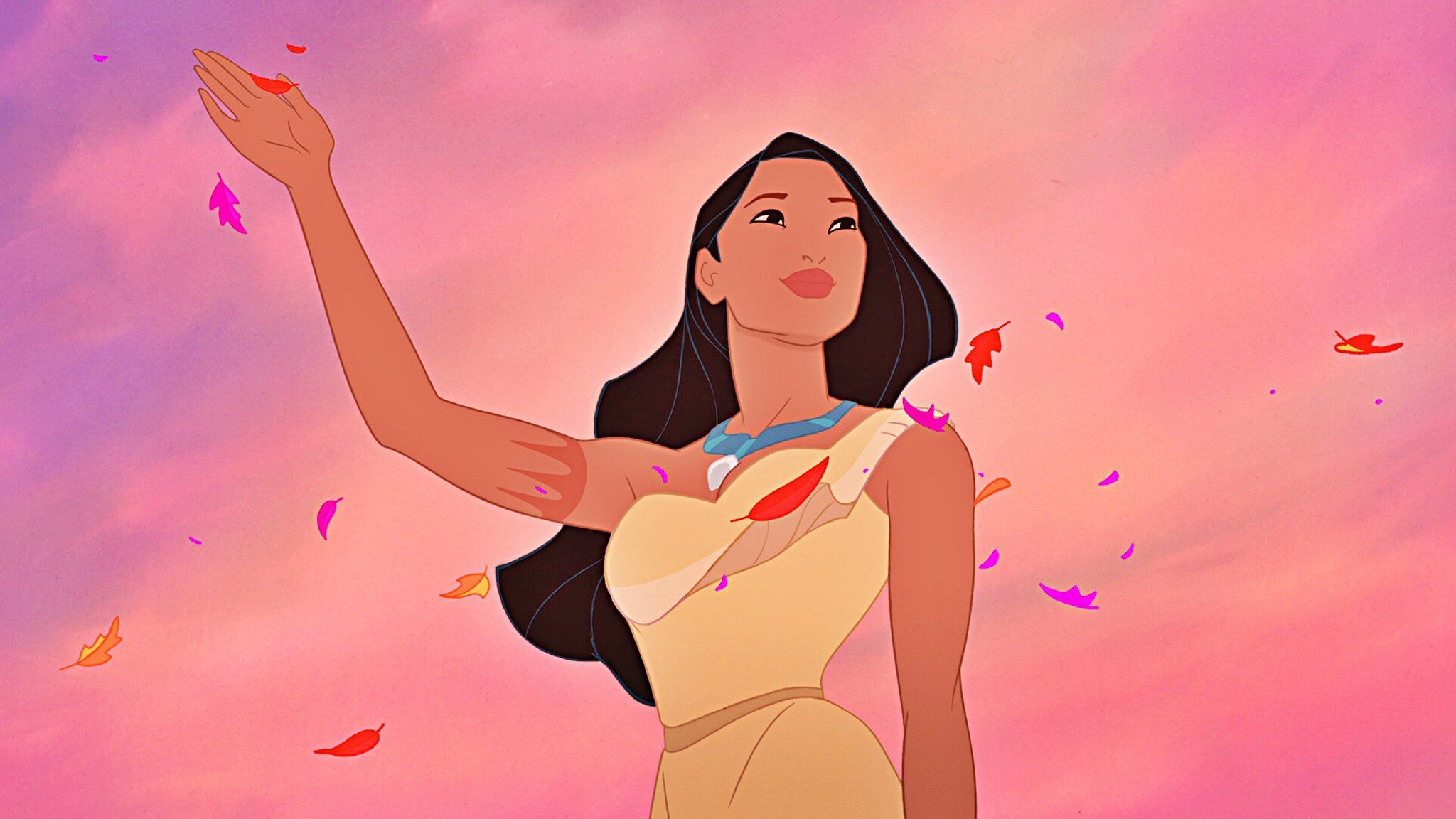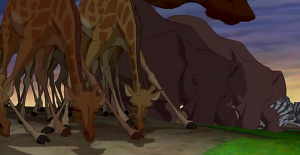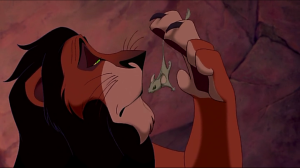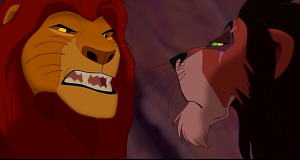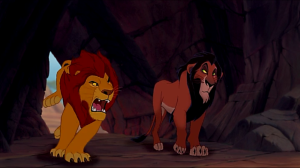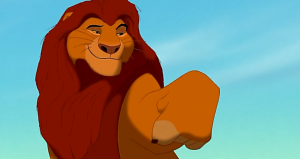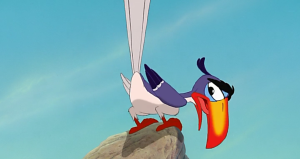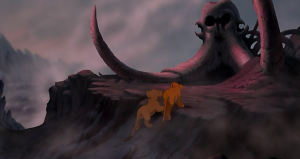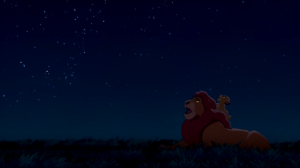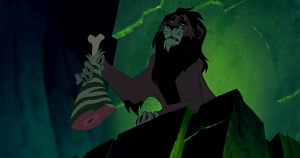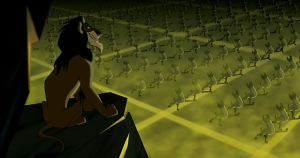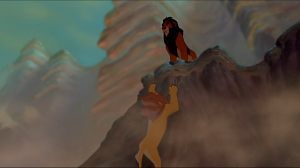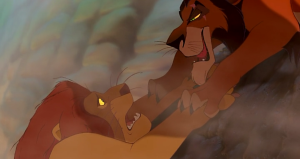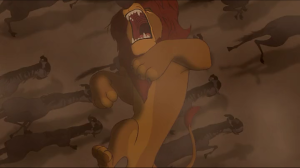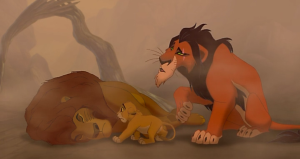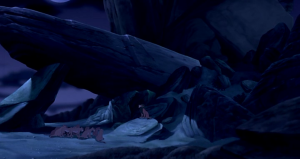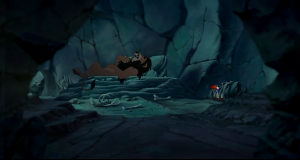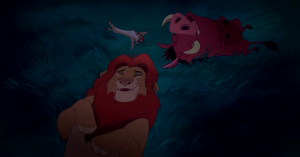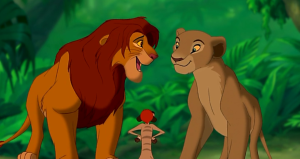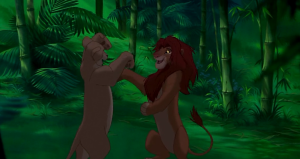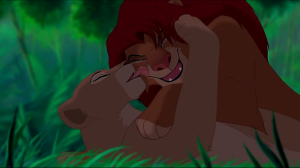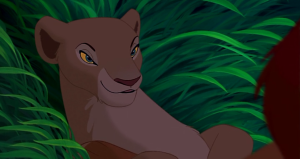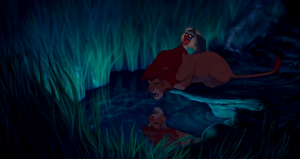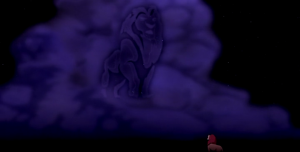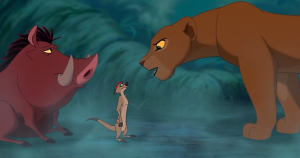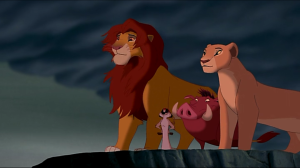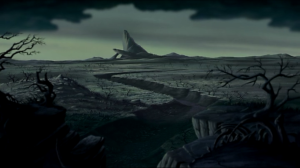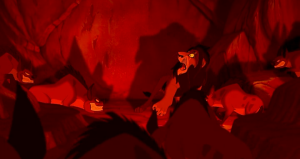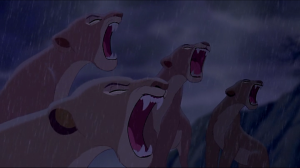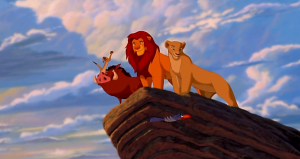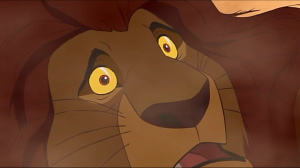When people talk about the fabulous era of Disney Animation called Disney Renaissance, they always have amazing memories of Disney's Fab Four:
The Little Mermaid,
Beauty and the Beast,
Aladdin and
The Lion King. All those films became masterpieces, made their mark on pop culture and made Disney the king of animation. But that Second Golden Age was shortlived by one Disney movie:
Pocahontas.
Yes, this is the film that got a strongly broken base with many of its problems picked apart by Disney and animation fans and enthusiasts. A movie that earned mixed reviews from critics, failed to repeat the commercial success of those previous Fab Four and its ghost would forever haunt Disney from the late 90s to the much of the 2000s. But is this film really that bad? Or are the critics, fans and Disney and animation purists right all along?
It all started with just one man: Jeffrey Katzenberg, the former boss of Walt Disney Studios and the hero of Disney Renaissance. After all, he was proud to admit that he was the source of that success. Katzenberg joined Disney in 1985, on behalf of his Paramount colleague Michael Eisner who was Disney's CEO in 1984 after everything fell apart at the end of the previous regime.
Katzenberg also accepted the fact that he didn't know anything about animation at first, as he infamously brutalized and raped
The Black Cauldron in post-production, removing some scenes allegedly considered violent. The creative team wanted an edgier movie for a teen and adult audience that Disney wished to cater to at that time, but Katzenberg shot that down. Futhermore, he slashed the budget for
Basil of Baker Street and changed its title to
The Great Mouse Detetive due to the failure of previous year's
Young Sherlock Holmes which was produced by his future Dreamworks founding partner Steven Spielberg. Too "British-sounding" could have been one of those reasons.
Years passed and Katzenberg was finally able to learn new things, though he was still ignorant towards the animation process (this time to a certain extent). During a test screening of
The Little Mermaid, kids in the audience were bored during one of the cores of the film, the "Part of Your World" sequence. Katzenberg wanted to cut it out just because a bunch of ass kids in the test audience got bored. And don't get me started with why
The Rescuers Down Under is one of the most underrated Disney classics.
Sure,
The Little Mermaid became a fantastic film, Disney's greatest since the days of Walt and miles ahead of the transitional era movies. It had everything that was lost from the post-Walt classics. The story was interesting, the pacing was finesse, the music was spectacular and the characters are the $#%t. All of this which made this film iconic. It surprised Katzenberg who thought this film wouldn't be as successful as previous year's
Oliver & Company because of the female protagonist.
Beauty and the Beast was originally developed as a more serious art film, an animated version of Jean Cocteau's 1946 film version of the classic story, directed by Richard Purdum. But Katzenberg was called to save this film and turned it into a musical comedy less unlike
The Little Mermaid. Rather than creating something fresh and new, Katzenberg wanted this film to be the spiritual successor of Disney's then-recent smash-hit, complete with the same people who did the songs of
The Little Mermaid! This is exactly what Walt himself would never have done. He made
Pinocchio as a completely different and original film, not a carbon copy of
Snow White and the Seven Dwarfs. His wise words taught me to never repeat yourself because "you can't top pigs with pigs", referring to how the sequels to his Silly Symphony short
Three Little Pigs weren't as successful as their first appearance. Ditto for his animated features.
Cinderella was his first princess fairy-tale classic in 13 years since the release of
Snow White and the Seven Dwarfs. However, that movie only shared few similarities with that earlier entry. It was not a rehash of it in zero means, nor was 1959's
Sleeping Beauty. Clearly, because those movies were based in different public-domain fairy tales, each with their own distinct versions.
But I understand that Disney Animation just wanted to survive, considering the plagues the studio had endured from the 1970s to the early 1980s. Just to pay it off,
Beauty and the Beast was saved by great storytelling, likeable characters and well-resonating songs. Despite his astonishing merits, it also foretold us why the Disney Renaissance would be relegated to a dated trend. His nomination for the Academy Award for Best Picture in 1992, while an historical achievement for an animated feature, was also when and where the cracks were starting to show. Had
Beauty and the Beast won the Academy Award for Best Picture, maybe this hadn't created a sort of arrogance. It was a new attitude, one that implied that Disney was making "high art" but at the expense of Walt's films.
Bambi? It's just a kids' movie, not a masterpiece. When those classics were first released on home video, most of the ads advertising them as babysitting toys. And people do nothing but whine on everything Disney does today and how it would sore the dick out of Uncle Walt.
As much as I've always enjoyed
Beauty and the Beast, which I still enjoy to this day, his monster success went over the Disney executives' heads. A power of making successful animated features that, just like any power, ultimately corrupts. On the otherwise excellent "Beyond Beauty" bonus documentary on the 2010 Blu-ray release of the film,
Beauty and the Beast was considered the first Disney animated film to get adults emotionally invested... HEY! What the (bleep) happened to
Bambi? Does someone remember the hearbreaking scene from
Snow White and the Seven Dwarfs where the dwarves are mourning her comathosis? I want my
Dumbo! And what about the Donald Duck/José Carioca's
Saludos Amigos/
The Three Caballeros duology?
On the original DVD release of
The Lion King, one featurette ended with the statement that
The Lion King was when Disney finally made "entertainment" instead of "children's entertainment" for all those decades... Today, many writers echo this statement. I come across thousands of articles about animation and their respective writers are all lured into this seductive, yet dastardly and lethal, trap. They say bullzap such as "animation wouldn't be actually adult or complex until the Disney Renaissance" or "animation was once kids' stuff before Disney Renaissance". As we all know, those statements are a ridiculously insulting outrage. Walt Disney really never intended his films for young audiences, but rather the popular masses. What about William Hanna, Joseph Barbera, Tex Avery, Chuck Jones, Bob Clampett, Walter Lantz, Max Fleischer and even Osamu Tezuka? They weren't targeting the young audience either. Not even the "children's movie" genre existed during the Hays Code era where every single Hollywood studio had to make movies first and foremost to wider audiences. Sure, those studios were producing the so-called "children's movies" in the Golden Age of Hollywood, but Walt Disney's studio certainly wasn't one of them. Perhaps the public finally saw Disney animation as for adults by 1994, but it's just because a certain era became a pain in the ass of animation, which persists to this day.
Anyway,
Beauty and the Beast was Disney Animation's first prestige picture. They collected universal acclaim, fatty box-office grosses, an Academy Award nomination... and ran with everything. Katzenberg and Eisner then greenlit
Aladdin, with the former making it his pet project. He wanted this film to top
Beauty and the Beast to make sure the film would get an Academy Award for Best Picture that its predecessor didn't get or at least another nomination. Despite this,
Aladdin was able to stand out thanks to its comedic zaniness and pop-culture references, something like that which wasn't in the previous Disney films while also experimenting some things. Because it was one of the most experimental and wacky Disney films of the era,
Aladdin was less of a prestige picture and more loose and comfortable and less at war with itself.
Released in 1992,
Aladdin still didn't get the golden statue, but because it was more experimental and wacky than
Beauty and the Beast, it wasn't even made with that golden statue in mind. Jeffrey Katzenberg, by this point, was already shifting his attention to
Pocahontas, which
The Rescuers Down Under director Mike Gabriel was pitching in 1990. Katzenberg only approved that project because he saw in it a perfect way to copy-and-paste
Beauty and the Beast: a big epic Broadway-style love story musical drama that touched the dark and wicked side of American history, and it would seamlessly mesh with the times, in a post-
Dances With Wolves world.
Meanwhile,
The Lion King, one of Disney's most famous animated movies, was being developed as a more experimental picture that Jeffrey Katzenberg and fellow suits didn't give a damn to, as they would rather stick to
Pocahontas which they viewed as their top priority. Even most of the Disney animators and artists at the time would rather work on
Pocahontas. But, surprisingly,
The Lion King became a universal blockbuster, collecting widespread critical acclaim and earning a load of money. That film won numerous awards despite still not getting an Academy Award for Best Picture nomination and, to this day, remains one of Disney's gems in the crown, a masterpiece with the same caliber that Walt's films, a merchandise triumph and a landmark in Disney and animation history.
On the other hand,
Pocahontas feels more like a Frankenmovie made by committee than a truly creative darling. A step back from the emotional love stories of
The Little Mermaid and
Beauty and the Beast, the sheer comedic entertainment of
Aladdin and the epic beauty of
The Lion King, it clearly follows Disney's 90's Standards and Practices that the executives forced the animation team to follow:
- A list of Broadway-style "burst out into song" tunes: a love ballad, a silly fun show-stopping sequence, the villain's evil song, the "I Want" song and the musical intro.
- Forced and undeveloped romance
- A generic good-vs-evil formula
- One or two cute and funny sidekicks to lighten the $#%t for little kids and to sell merchandise gallore.
See? This so-called Disney formula is the Save the Cat! of animation. It's the reason why you should not aim Disney Animation for kids first and foremost! Walt Disney's movies became timeless masterpieces because he didn't aim them for kids, he created movies that would be respected by audiences. Walt even taught me that appealing only to kids would be self-destruction. Like I said, those misconceptions about earlier Disney animation show their true, vile and diabolical face and colors which would haunt the poor defenseless animation studio that Uncle Walt built with so much love, heart, effort and sacrifice through the last days of the Renaissance. The desperate attempt to attract the lowest common denominator would be this movie's kiss of death.
This was already felt in previous Renaissance films. For example, The Lion King had fart jokes, intrusive slapstick and humor during the intense climax and managed to hinder his dramatic intentions. Walt never did this in his films. He and his Nine Old Men balanced comedy and darker subject matter with brillance. Pocahontas not only suffers from these minor issues, it cranks them up to 11.
But the worst part of this film is that the story doesn't explore its subject matter properly. It was already boosted with an interesting conflict between two kinds of people having their prejudices towards each other, illustrating it well enough from the beginning with the natives' suspicions about the pale visitors and the British settlers' concerns in regards to the "savages". This theme of prejudice could have been explored more deeper if it wasn't for the big bad Ratcliffe who's just there after gold. Rather than addressing the themes of racism and prejudice with beauty and mastery, the suits instead pandered to the lowest common denominator by shoving a cartoony villain who blows everything up. He's the one to blame for why this movie fell flat. He needlessly makes the conflict worse. The love story of Pocahontas and John Smith is just a B-plot. This makes me question: why have a villain when you could just let the prejudice from both natives and settlers be the main conflict?
It's why this movie disappointed the critical consensus. It talks down to both adults and children. Another thing that Walt refused to do with his output. He viewed the audience, regardless of age, as smart and someone who could appreciate the storytelling of his film in some level. Pocahontas wanted to be Dora the Explorer: The Movie even before Dora made her debut on Nick Jr. You can also show younger children the dangers of prejudice and racism with no need of a villain who only gives a damn to riches or material possessions. Compare this film to one of the studios most recent classics, Zootopia. Despite not based in a real-life story, Zootopia, as a modern Aesopian fairy tale, deals with modern-day prejudice, biases, generalizations, mass media manipulation and political corruption. It wasn't hammered to the lowest common denominator. It seamlessly fit its action-adventure story, it had an edge or reason for being part of the story from start as it had business in the film's world building. The big bad from that film uses that fear for the sake of her pride and for the sake of beating the poor piss out of the predators to whom she has a distaste. She alone doesn't deserve the blame. The heroes have their prejudices as well. The chemestry between the characters amazingly showcases the biases and generalizations at work, not exposition or over-the-place histriony. All because the Disney Animation of today is artist-driven and is no longer run by executives who don't give a f#%& to the art of animation. Those mindless executives would rather stick to Sony Pictures Animation, specially after teasers and trailers from The Emoji Movie have been released to public outcry.
The animators, artists and creative team did everything they could, despite all of that. And it was paid off. So,
Pocahontas balances the jaw-dropping and mind-boggling with finesse. The film's art direction is
TERRIFIC, particularly its color palette and minimalism, at the time when TV cartoons such as
Batman: The Animated Series,
Dexter's Laboratory and the classic version of
The Powerpuff Girls became instant hits and were awarded for their minimalistic visuals. The character animation is top-notch despite most of the human designs being very flat. The animals are designed as though they came from an old TV cartoon, none of those designs are really fit at all. As I'm saying, the filmmakers delivered it amazingly! The film's direction and its signature visuals really managed to save it.
This level of dedication from the animation department made sure the film wasn't really that bad, but still it wasn't good either, making
Pocahontas a truly mixed bag. The executive-ordered dickery appals me as an animation purist and as a person who doesn't want entertainment to treat me like a dumbass. But the animation, visual design, music, direction and execution masterfully made up for the meddling. No different from
The Fast and Furious saga, whose installments are not worthy of cinema but remain critically improving with each installment and feature a talented cast playing relatable characters and beautifully filmed action scenes. Also, the story is also a feast despite Pocahontas and John Smith being rather bland characters.
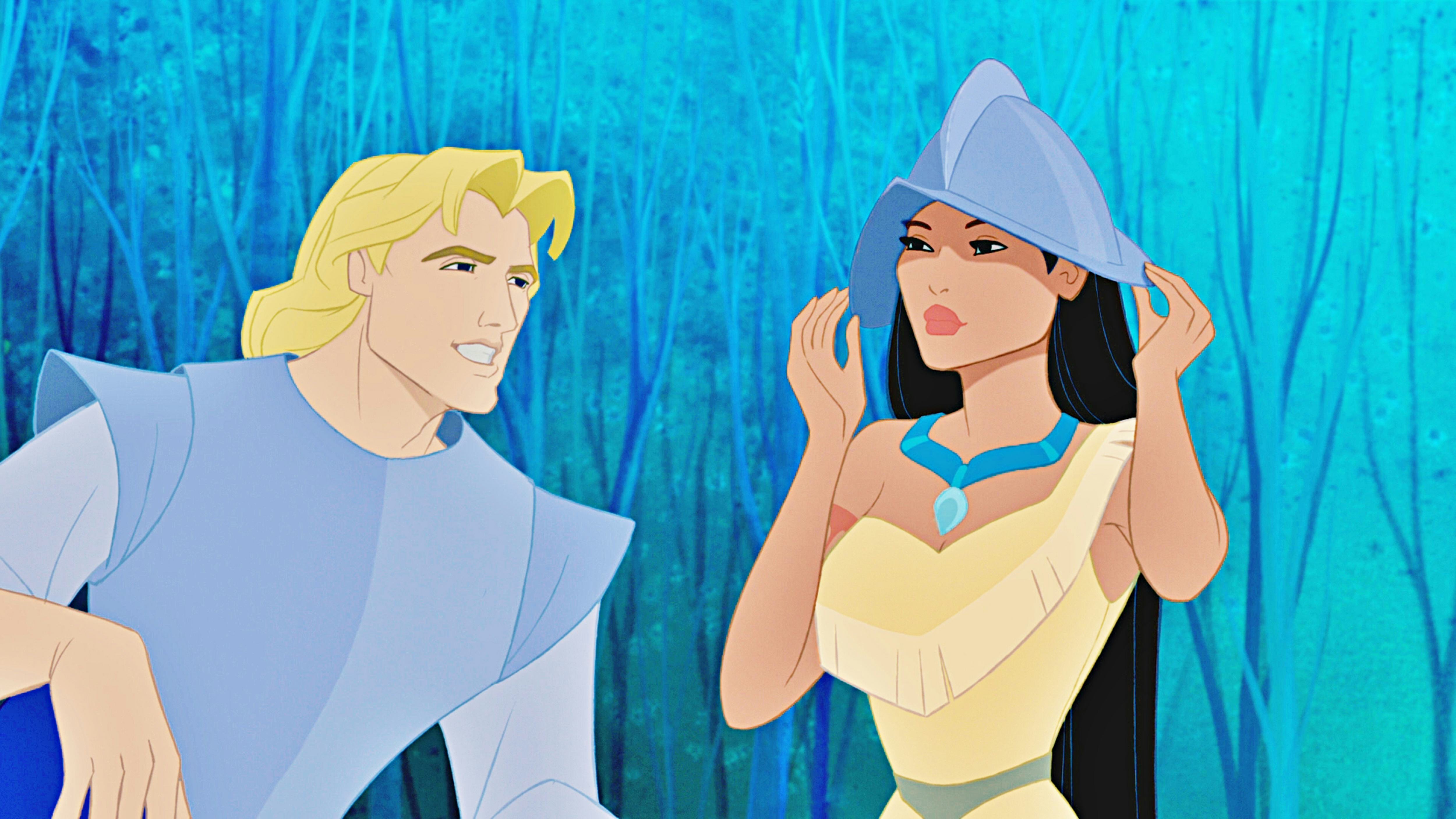
And the music is average at best, because it's beautiful and cringe-inducing at the same time. "Colors of the Wind", a beautiful and magnificent song as it is, could have been written better. "Savages"? Uuuuuggghhh... This is the most offensive stereotype ever, but the tune is catchy and cool. "Just Around the Riverbend" is better than those two, just a typical "I Want" musical sequence or not. (see number one on that list of 90s rules). But the best songs of this movie are the intro sequences: the noblish "Virginia Company" and the majestic "Steady as the Beating Drum". As for the beautiful and heartwarming love ballad "If I Never Knew You", poor song... It was left out from the movie, all because those dickish suits! I'm glad that justice is served in the DVD release and let that be a lesson for those clueless executives.
The last song is the film's villain song "Mine. Mine! MINE!" It sucked because it was sung by the one-dimensional villain, making it border on parody, but I still love it. Bombastic, energetic, catchy and so over the top that it's no wonder some people enjoy this song. That's because, like I said, the animators, musicians, actors and directors put a load of heart and effort on that sequence. If this film wasn't based on Pocahontas or any other real-life event, maybe this could have made it a decent animated musical.
After all that, the greatest problem with this film is that it had no idea of what were its ambitions. Not only Jeffrey Katzenberg and his fellow executives wanted that golden statue called Oscar and that prestigious status, they also wanted to make something more appropriate for little kids and something that would sell a load of merchandise. Good art and capitalism don't mix well, and this dysfunctional combination is what killed this already misguided Disney classic.
Pocahontas is not a good film nor a bad one, it's just a poor defenseless innocent victim of the hurtful war between the suits and the artists, and it clearly showcases how clueless and absolutely ignorant the former were at the time. It's no wonder it underperformed critically and commercially, compared to the likes of
Beauty and the Beast,
Aladdin and
The Lion King. After its release, the film was further scrutinized by Native American and Christian organizations, the latter had Disney as their favorite target at the time.
The last straw was Pixar's
Toy Story which was released in the same year than
Pocahontas and changed animation history forever. It was fresh, smart, more adult (by just naturally doing what it vowed to do), excelent for all ages, groundbreaking and something new.
Toy Story was different from the Disney Renaissance films and was more akin to Walt's earlier classics in his ambitions and the load of effort put into them. Sadly, Disney would rather stick to the formula until it ran its course, only to embrace the new things in the very wrong way. It's no secret that Disney purchased Pixar as the anthedote required to cure Disney Animation's disease over a decade after
Pocahontas was released: the suits' diabolical powers.
Pocahontas is exactly the generalizations about Disney Animation itself fused into one Frankenmovie made by committee. It's the very reason why people hate Disney needlessly and why Disney Animation is still viewed as kiddie stuff. Katzenberg left Disney when the film was in physical production, storming off to form Dreamworks Pictures with Steven Spielberg and David Geffen. Dreamworks was made into a major animation powerhouse by the likes of
Shrek, whose widespread critical acclaim and commercial success would become more of a pain in the ass of Disney Animation. Katzenberg's infamous heated relationship with Eisner was over and Disney Animation started to slowly die despite his few successes, as the executives went to follow Napoleon Bonaparte's footsteps as the millenium rolled in. Following the merger, Disney Animation was saved from the horrors of Michael Eisner and the other suits by the likes of
Wreck-It Ralph,
Frozen,
Big Hero 6 and
Zootopia. The force awakens. (Delightful
Star Wars in-joke, isn't it?)
As time has passed, this film's shortcomings are slightly more forgivable today. Now it's just an average movie that was cruelly mistreated and abused by the stupid ass suits. Reaction to this film has become more acceptive and some fans fully embrace it for its daring and edgy merits while others simply love it for the sake of nostalgia. Sometimes, an inferior product can be fascinating to enjoy because of its shortcomings. Why is Spider-Man's Clone Saga the worst of Marvel Comics? Why are
Teen Titans Go! and the 2016 version of
The Powerpuff Girls considered the worst that Cartoon Network has to offer? Why are
Breadwinners and
Fanboy & Chum-Chum labeled as the worst Nicktoons ever? Why are
Quack Pack,
The Buzz on Maggie,
Pickle & Peanut and
Fish Hooks deemed as the worst Disney TV cartoons? Why is
Batman vs. Superman: Dawn of the Justice treated as the cancer of the DC brand? And why is Disney Channel a spit to Walt's name and legacy? I love this movie mostly for its animation, production design, musical score, voice acting, directing and the huge load of effort poured into those areas. The songs, regardless of their lyrics, sound fun and unforgettable. This movie has its greatest moments that tell me how much better it could have been.
Because of this,
Pocahontas is considered the black sheep of the otherwise glorious Disney Renaissance. Apart from some of his excellent aspects, it was hindered by too many cooks who spoiled a perfect dinner. This film gets a flack for his pretentious attitude and unclear vision, but does it deserve all of this unneccessary spite? Fuck NO! It's just a great and beautiful way to teach how to NOT make an animated movie. If only Sony Pictures Animation had learned from those pitfalls...






